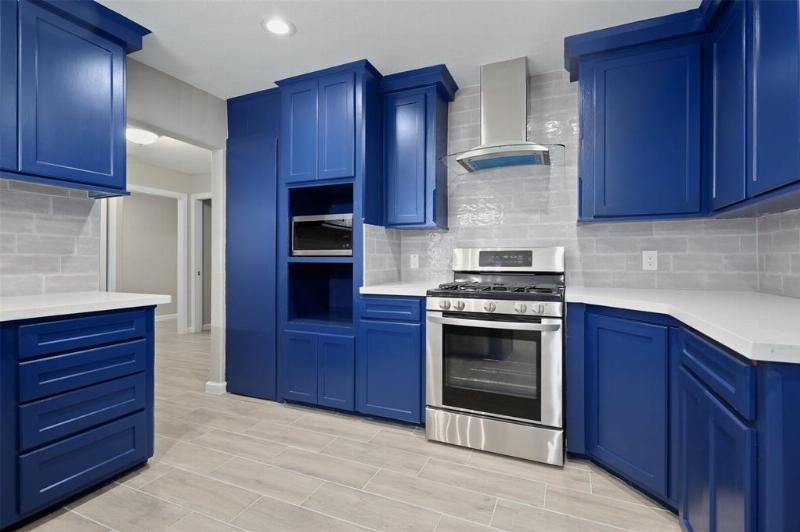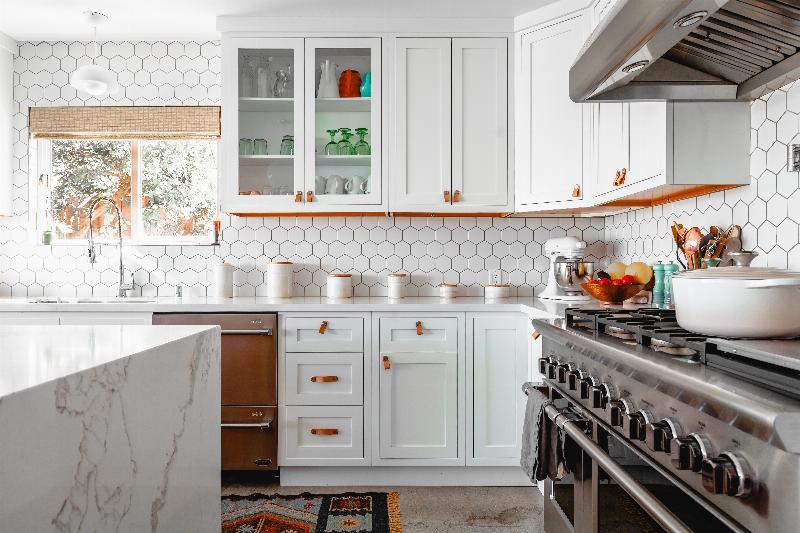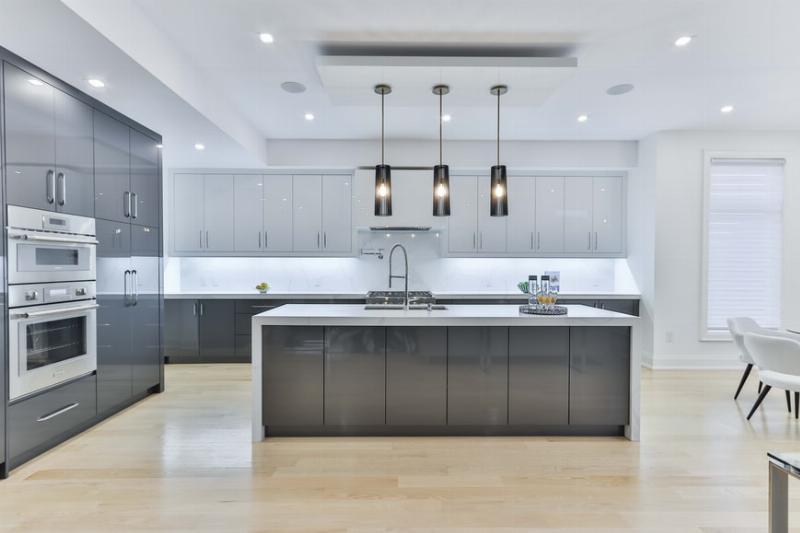Full Height Cabinets
Full-height cabinets are often termed “upper cabinets” or “uppers.” In this article, we’ll use the term “full-height cabinets” to make things clear. Cabinets that go all the way up to the ceiling are some of the most flexible and useful. Different styles, sizes, depths, shapes, and designs are available.
The best way to store things in the kitchen is in full-height cabinets. They give you more room and let you store a lot of things without making your kitchen look messy. You can always change the shelf heights in tall cabinets to fit your needs.
This lets you keep food, groceries, vegetables, and other things organized way.
Sizes
|
Length |
84, 90, and 96 inches |
|
Depth |
12 to 24 inches deep |
|
Width |
12 to 33 inches wide |
Using this type of design for your kitchen has many benefits. Full-height kitchen cabinets have many benefits, such as:
|
Storage space |
Versatile |
|
Stylish |
|
Storage space
Instead of a huge wall, build ceiling-high cabinets around your kitchen. Cabinets hold everything. No more base cabinets are needed. Unused dishes, pots, pans, and cookbooks are easy to store. This reduces kitchen table and counter clutter. Because your kitchen has so much storage, you can buy everything you need.
Versatile
Depending on what you want, these kitchen units can have drawers or shelves for storage. This choice may help you stock your kitchen with valuable items. These units have more storage than ordinary ones, adding kitchen space.
Stylish
Full-height or tall kitchen cabinets work in classic or contemporary kitchens. The design stands out since there is no work table or splashback in the middle.
Cabinets can have a big effect on how a room looks and feels. In kitchens, they are the main attraction. (MT Copeland 2021)
To make stylish, long-lasting cabinets, you need to know about the different materials. Know their benefits and downsides.
Materials often used to make cabinets
|
Plywood |
Particleboard |
|
MDF |
PVC |
|
Wood |
|
Plywood.
It is made of thin wood sheets layered with grain running in opposing directions. Cabinets made of plywood don’t move as much as solid wood cabinets do when the wood swells and shrinks. Alternating grains help screws and other fasteners cling to the board.
Pro Tip takeaway: Because kitchens are wet and steamy, use Boiling Water-Resistant (BWR). They’re good for kitchens since they can tolerate water. BWR is pricey but ideal for the kitchen since it’s sturdy and won’t mold.
Advantages
|
Lightweight |
Solid and long-lasting |
|
It is stronger than most cabinet materials because it has a cross-grain. |
It doesn’t break, stretch, or grow. |
|
Long-lasting beauty |
Environment-friendly |
MDF
Medium-density fiberboard, or MDF, is also a popular choice for cabinet cases. It is made of wood. It is made of fibers that are covered with thin veneers. It has the advantage of being completely flat and ready to be painted. But, because MDF is made of fibers, it doesn’t hold fasteners well.
Pro tip takeaway: If you’re using MDF, drill holes for fasteners and glue them to secure them.
Advantages
|
Hard to break |
If you try to bend an MDF board, it is more likely to break than to bend. |
|
Affordable |
MDF boards cost less than natural wood. Of course, if you compare high-end MDF to some of the cheaper types of wood, there are a few differences. |
|
Best Material |
There is no doubt that engineered wood is a good choice for cabinet doors. Many types of MDF are more resistant to water. which is important for furniture in the kitchen and bathroom. |
Disadvantages
|
Damaged by heat |
wood is made of wax and/or things that look like resin. Because of this, you shouldn’t put MDF units near heaters, radiators, fireplaces, ovens, or stoves, or leave them outside in the summer. |
|
Cannot sustain a lot of weight |
Overweight MDF boards may slump. Smart solution: use sturdy wood and MDF. |
Particle Board
Wood chips, sawdust, and resin make particleboard.
Pro Tip Takeaway: These can become very brittle and break. When they get wet, they can swell up and sort of fall apart, and they are full of formaldehyde. ” Because of these things, many builders only use particleboard for temporary structures.
Advantages
|
Cheap |
Wood dust and glue make particleboard. It is cheaper than plywood and actual wood. |
|
Pre laminated |
Gluing plastic laminate or veneer to particle boards adds attractiveness. |
|
light |
Particleboard is lightweight and simple to transport. |
Disadvantages
|
Bendable |
When exposed to water and humidity, particleboard furniture may warp and swell. |
|
Unreliable |
solid wood, plywood, and other fiberboards survive longer than particle boards |
|
Weak |
Particleboards are weak and don’t last long. Can’t take much weight and may break from kitchen objects. |
|
Not as secure |
Urea-formaldehyde particleboard This resin releases formaldehyde if the seal isn’t good. Solid wood may be dangerous. |
PVC
PVC is a sheet made of plastic and other materials. PVC is often associated with pipes, restrooms, and plumbing supplies. But PVC is now used for a lot of other things because it is strong and easy to get. PVC kitchen cabinets are prevalent as modular kitchens gain popularity.
For kitchen cabinets, there are two kinds of PVC board: PVC hollow boards and PVC foam boards. Like their name says, PVC hollow boards are hollow on the inside. But PVC foam boards are stronger and thicker than hollow boards. PVC can be shiny or matte, but hollow boards have little thermal resistance and sag. But PVC foam boards are strong and can stand up to heat well.
Pro Tip Takeaway: Hollow PVC boards aren’t strong enough to be used for long-term kitchen cabinets.
Consider PVC’s pros and cons before using it for kitchen cabinets.
|
Economical |
PVC is more cost-effective and cheaper than other materials when it comes to cabinets. The cost of PVC hollow boards is less than that of PVC foam boards. |
|
Install ability |
PVC kitchen cabinet material comes in a variety of colors and as ready-to-fit boards. These pre-assembled boards are lightweight and simple to install in your kitchen. There are no more laminations or designs required to fit them. |
|
Zero Maintenance |
Since PVC cabinets are made of plastic, they are very easy to clean and don’t hold any stains. This means that PVC almost never needs to be fixed. |
|
Termite resistant |
Cabinets made from PVC are impervious to termites, wood-boring insects, and other insects. These materials are resistant to termites, water, oil, and corrosion. After installation, the material will remain unchanged. |
|
Source ability/replaceability |
Materials made of PVC are easy to find on the market. So, you can replace PVC boards or sheets at any time. |
|
Durability |
PVC foam boards are more sturdy and long-lasting than other types of PVC. Also, PVC doesn’t rot, so it can be used for a longer time without doing any major damage. |
Cons of Using PVC for Kitchen Cabinets
|
Incompatibility |
PVC boards are easy to set up and use, but the hardware is hard to work with. The screws and hinges that hold PVC boards together weaken over time, allowing them to sag. PVC boards are weaker than plywood or real wood. |
|
Flammability |
A kitchen is a place where heat, oil, and water can damage the furniture. The PVC-board kitchen cabinets don’t keep heat or fire out very well. So, you have to be very careful if you want to put PVC cabinets in your kitchen. |
|
Scratches-prone |
Plastic PVC cabinets may suffer permanent scratches or cuts over time. Make sure you don’t put anything sharp on your cabinet boards. |
Wood
Wood is another way to make your kitchen look better. It has the right amount of style and durability. The wood’s texture and grain complement modern and rustic kitchens. So, wood is one of the most common materials used for kitchen cabinets in Indian homes.
There are many ways to use wood on the market. Make them your own by adding graphics or painting them to match your kitchen décor (Real Homes 2022)
Here are the types of wood that are most often used for kitchen cabinets:
Teak is a popular material for traditional and contemporary furniture. It’s sturdy and robust. Teak wood lasts a long time and can tolerate harsh heat and cold.
Mahogany Manipur is where Indian Mahogany comes from. The price of mahogany wood is lower than that of teak and rosewood.
Pinewood is known for being soft and easy to work with. It’s sturdy and doesn’t break, so cabinets and classic kitchens use it.
Advantages of using wood
|
Cleanability |
Because they are used so often, kitchen cabinets get a lot of wear and tear. This is why many people choose wood cabinets. No matter how bad the stains are, it’s easy to clean the surface of a wooden cabinet. |
|
Durability |
Once you put wooden cabinets in your kitchen, you don’t have to think about it again. They’re durable, although it depends on the sort of wood utilized. If there are any dents or stains, you can fix them with sandpaper and a new coat of stain. |
|
Profitable resale |
Wood has always been in high demand everywhere, and so is having things that are carved out of wood. So, if you are remodeling or moving, you can always sell your wooden cabinets and other wooden items for a good price. You may appreciate the beauty it gives to your house and sell it if necessary. |
Disadvantages of wood
|
High Maintenance |
Clean wood cabinets. They need constant maintenance. You may buy wood-cleaning products on the market. Different oils can polish wood and make it seem fresh. |
|
Expensive |
The price of wood goes up because it is of high quality, can be used in many ways, and lasts longer. So, when you are building or remodeling your kitchen cabinets, you need to be careful with your budget. |
|
Hard to install |
Wooden cabinets are harder to assemble than PVC pieces. Each piece of your kitchen cabinet needs to be measured and shaped so that it fits with the other pieces. |
|
Termite-prone |
Termites, wood borers, and other pests will devour untreated wooden cabinets. Not only that, but once it’s in place, you need to keep an eye on it often to make sure termites don’t destroy it. |
|
Decays |
Wood isn’t waterproof or moisture-resistant. It rots, decays, and breaks down if exposed to water, moisture, or steam. So, avoid getting liquids on the wood. |
|
Humidity-prone |
Wet wood is another concern. The weather may harm wood cabinets. Wood may expand or shrink as air moisture changes, causing damage. |
Are You Ready To Remodel Your Kitchen Cabinets to Full Height?
Kitchens are nostalgic places where we build memories. Invest time in research, choose the right materials, and design the kitchen to your liking. Schedule a free design consultation at sales@smartremodelingllc.com.








